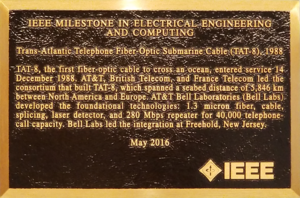Milestones:Trans-Atlantic Telephone Fiber-Optic Submarine Cable (TAT-8), 1988
- Date Dedicated
- 2016/05/19
- Dedication #
- 164
- Location
- AT&T Labs, 200 S Laurel Ave., Middletown, NJ 07748, U.S.A.
- IEEE Regions
- 1
- IEEE sections
- New Jersey Coast
- Achievement date range
- 1988-1988
Title
Trans-Atlantic Telephone Fiber-Optic Submarine Cable (TAT-8), 1988
Citation
TAT-8, the first fiber-optic cable to cross an ocean, entered service 14 December 1988. AT&T, British Telecom, and France Telecom led the consortium that built TAT-8, which spanned a seabed distance of 5,846 km between North America and Europe. AT&T Bell Laboratories developed the foundational technologies: 1.3 micron fiber, cable, splicing, laser detector, and 280 Mbps repeater for 40,000 telephone-call capacity. Bell Labs led the integration at Freehold, New Jersey.
Street address(es) and GPS coordinates of the Milestone Plaque Sites
AT&T Labs, 200 S Laurel Ave, Middletown, NJ 07748 US, (GPS: 40.3973552, -74.1376984)
Details of the physical location of the plaque
In the ground floor entrance hall lobby.
How the plaque site is protected/secured
The site is within the AT&T security perimeter. Visitors are required to sign in at the front desk.
Historical significance of the work
See URL - http://www.ieeeghn.org/wiki/index.php/Oral-History:Jack_Sipress TAT-8 was the first transatlantic cable to use optical fibers, a revolution in telecommunications. It had a capacity equivalent to 40,000 telephone circuits which was ten times the capacity of the last copper cable. Several new technologies had to be developed which were beyond those for land applications: (a) strong enough fiber strand and undersea cable that required ten times the strength available with typical fibers of that time; (b) strong splicing to withstand the rigors of the ocean as well as the laying of cable or pull up and repair of the cable at the fault location; (c) 1.3 micron wavelength single mode fiber and matching lasers and detector technology; (d) silicon for repeaters running at 280 Mbps and with very low failure rates. These resulted in far fewer repeaters and thinner cable than the copper submarine cable.
Features that set this work apart from similar achievements
This was the first submarine fiber-optic cable system and several new technologies were developed rapidly for this purpose. The lessons learned were incorporated in later systems such as submarine cable systems across the pacific and around the world. Later terabit fiber-optic submarine systems that make the internet of today possible build on this strong foundation.
Significant references
[1] An easy to read article is available on Wikipedia, http://en.wikipedia.org/wiki/TAT-8 [2] Jack Sipress, an oral history conducted in 1999 by David Hochfelder, IEEE History Center, New Brunswick, NJ, USA, http://www.ieeeghn.org/wiki/index.php/Oral-History:Jack_Sipress [3] First laser phone call zips across the Atlantic! Isaac Asimov dedicates TAT-8 http://massis.lcs.mit.edu/archives/history/tat-8.fiber.optic. Also appears in Telecom Digest V8 issue 202 12/16/88. [4] Milestones in AT&T History, http://www.corp.att.com/history/milestones.html [5] The Voyage That Changed The World, International Cable Protection Committee, Dec. 1, 2008, http://www.iscpc.org/publications/ICPC_Press_Release_01-Dec-08.pdf
Map
